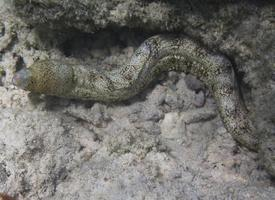
Poids et mesures
| Longueur | 1,5 m |
|---|---|
| Poids | 14 kg |
Statut de conservation
| Menacé |
Description de l'animal
The Mediterranean moray (Muraena helena) is a captivating species of moray eel found primarily in the rocky shores and seagrass beds of the Mediterranean Sea, as well as in parts of the eastern Atlantic Ocean, from the British Isles to the coast of Senegal. This marine creature is distinguished by its elongated, serpentine body, which can reach up to 1.5 meters in length, though most specimens are usually smaller. Its skin is smooth and lacks the scales found on many other fish, with a mucus layer that provides protection against parasites and helps the eel to slip away from predators.The coloration of the Mediterranean moray is particularly striking, featuring a dark brown to almost black base, adorned with a pattern of yellow or white spots and irregular lines along its body. This not only serves as camouflage amongst the rocky sea floor and within crevices but also makes it a subject of fascination for divers and marine enthusiasts.
Muraena helena has a somewhat fearsome reputation, partly due to its appearance and partly because of its sharp, needle-like teeth. It has a powerful jaw capable of inflicting serious wounds, though it is important to note that this species is not aggressive towards humans unless provoked or threatened. Its teeth are specially adapted for gripping and tearing its prey, which includes a variety of fish, cephalopods, and crustaceans.
The Mediterranean moray employs a unique hunting strategy. It often lies in wait within crevices or under rocks, extending only a part of its body or head to survey its surroundings. When a potential prey item comes within reach, it strikes with remarkable speed, catching the prey off guard. At times, it may also venture out of its hiding spots to hunt, especially during the night.
Reproduction in Muraena helena involves the release of eggs and sperm into the water, where fertilization occurs externally. This usually takes place during the warmer months. The larvae are planktonic, drifting with ocean currents until they grow large enough to settle on the sea floor and begin their benthic life cycle.
Despite its robust appearance, the Mediterranean moray faces threats from human activities. Overfishing, habitat destruction, and pollution are significant concerns that impact its population. Additionally, it is sometimes caught as bycatch in fisheries targeting other species.
In terms of interaction with humans, aside from the occasional interest from divers and marine photographers, the Mediterranean moray is also valued in some Mediterranean cuisines. However, care must be taken when preparing and consuming this fish, as it can accumulate ciguatoxins from its diet, which are harmful to humans.
Overall, the Mediterranean moray is a fascinating and vital part of its marine ecosystem. Its presence indicates a healthy, biodiverse habitat. Conservation efforts are essential to ensure that this species, along with the myriad of life it represents, continues to thrive in the Mediterranean Sea and the adjacent Atlantic waters.
Animaux similaires
Nouvelles photos d'animaux
Top 10 des animaux
- Dolphin gull (Leucophaeus scoresbii)
- Japanese macaque (Macaca fuscata)
- Stone loach (Barbatula barbatula)
- Greek tortoise (Testudo graeca)
- Russian tortoise (Testudo horsfieldii)
- Galápagos tortoise (Geochelone nigra complex)
- Diana monkey (Cercopithecus diana)
- Moustached guenon (Cercopithecus cephus)
- Common flying dragon (Draco volans)
- Galápagos penguin (Spheniscus mendiculus)
